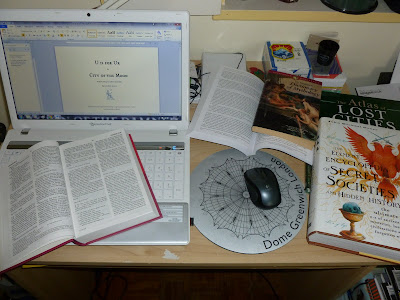Now don't get me wrong; not every short story is the marathon this last one has been. I've been doing this long enough to have picked up a few tricks of the trade along the way and sometimes the process goes like a dream. However, I really struggled with this last piece and it was all to do with finding the shape of the story.
Let me fill you in on a little background. I pitched the idea for this story some months back, during the course of a Facebook conversation between myself, Sandra Norval and Dean M Drinkel (he of Phobophobia fame). The idea just came to me there and then and everyone seemed to agree it was a goer, but at this stage - and this is the important thing - it was only an idea.
As any writer worth his or her salt will tell you, that's the thing about ideas. They're just ideas; some good, some bad. When people ask me where I get my ideas from I'm sometimes tempted to reply with another question: "What, you don't have ideas?"

A writer will have half a dozen 'ideas' before breakfast. The trick is being able to separate the wheat from the chaff, to know which to run with, which to twist or add to a stronger idea, and which to dump altogether, like barrels of toxic waste off a cliff.*
The particular idea in question was for a story for the forthcoming Cities of Death, about the ancient Sumerian city of Ur. I thought (as did the others) that this idea could go the distance but as I sat down to write it I realised I needed to beat it into shape, to literally** find the shape of the story.
When I plot a novel I can spend days writing notes in one of my large notebooks, gradually teasing out the strands of story hidden within all the crazy ideas I want to include, before I even set fingers to keyboard to produce a synopsis for my editor to see. With this story I went in cold, and that was the problem.
I spend a lot of time thinking about short stories when I'm writing them. Even if I only manage a couple of hours during the day I'll find myself thinking about the story I'm currently writing when I'm in the shower, at lunch, at the supermarket, in bed just before I drop off to sleep, in the morning when I first wake up...
This particular story left me with all sorts of confounding questions. Do I write it in the past tense or the present tense? The first person or the third person? Do I present it as a series of 'found' documents? Do I write it in reverse chronological order, encountering different people throughout different historical periods?
By day three it still wasn't working for me. So I started it again. And again. And again.
In the end I beat the thing into submission, but it was a battle, I can tell you. This was how my work space looked as I came to the end of my revisions on version... oh, I forget... of the story:

It's not particularly long (it's less than 5,000 words) but it's taken far longer than it should to actually write the damn thing. But was all that time and all those re-starts worth it? We'll just have to wait and see - I'm yet to hear back from Dean.
Here's my work space now:
 I'm researching, and have started writing, the next short story on the slate, a tale for Pandemonium Fiction's forthcoming Stories of the Smoke. Only now this story's starting to misbehave too - hence me taking the time out to write this blog post.
I'm researching, and have started writing, the next short story on the slate, a tale for Pandemonium Fiction's forthcoming Stories of the Smoke. Only now this story's starting to misbehave too - hence me taking the time out to write this blog post.Let's hope it doesn't take as long as the last one. Wish me luck!
So until next time...
~~~
"Writing is easy: All you do is sit staring at a blank sheet of paper until drops of blood form on your forehead.”
(Gene Fowler, American journalist, author and dramatist)
~~~
* Today's post was brought to you by the letter S for 'Similie'.
** Literally? Perhaps not 'literally' literally!

No comments:
Post a Comment